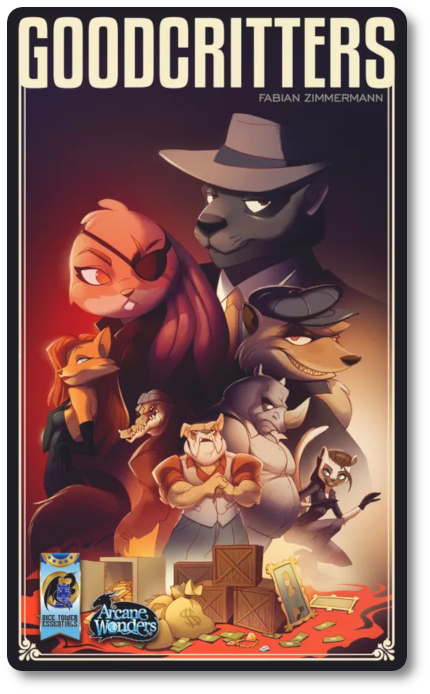
The Basics:
- For ages 12 and up
- For 4 to 8 players
- Approximately 30 minutes to complete
Geek Skills:
- Active Listening & Communication
- Counting & Math
- Logical & Critical Decision Making
- Emotional Coping Skills
- Hand/Resource Management
- Self-confidence
- Imagination
- Bluffing and Misdirection
Learning Curve:
- Child – Easy
- Adult – Easy
Theme & Narrative:
- Time to divide up the loot, but who said it had to be fair?
Endorsements:
- Gamer Geek mixed!
- Parent Geek mixed!
- Child Geek approved!
Overview
The Italian-born gangster who operated mainly in the United States, Lucky Luciano, said, “There’s no such thing as good money or bad money. There’s just money.” This game is about getting the cash you feel is rightfully yours using whatever methods you believe are right or wrong. This is an exercise in bribes and bluffs, making quick friends and bitter enemies. In the end, it’s all about getting paid, but how much are you willing to pay?
GoodCritters, designed by Fabian Zimmermann and published by Arcane Wonders, is comprised of 140 Loot cards, 40 Action cards, 40 Payoff cards, 16, Payoff tokens, 1 “The Fuzz” card, eight Threat makers, one Boss marker, and nine plastic stands. The game component quality is excellent. All the cards are as thick and durable as your standard playing card, and the markers are made of thick cardboard. Illustrations by Valerio Buonfantino and Stephen Gibson portray the world through fun anthropomorphism depictions of the “good guys” and the “bad guys.”
Meeting at the Safehouse
To set up the game, first have each player choose a critter they want to play with and take all the matching pieces associated with their selected critter (one plastic stand, one Threat maker, and five Action cards of the same color). There are eight different animal mobsters in the game, each depicted on the back of the Action cards. While neat to look at, there are no differences between these animals.
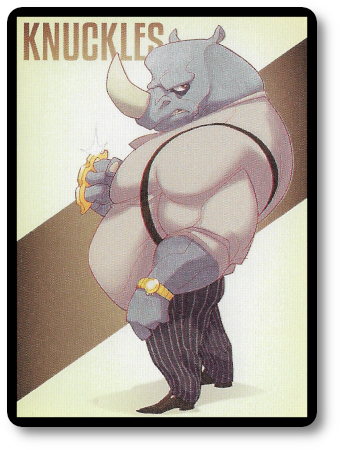
Second, give each player four Loot cards (one each in the values of $2000, $3000, $4000, and $5000). This is the player’s starting “Stash.” Players should always keep their “Stash” hidden from their opponents.
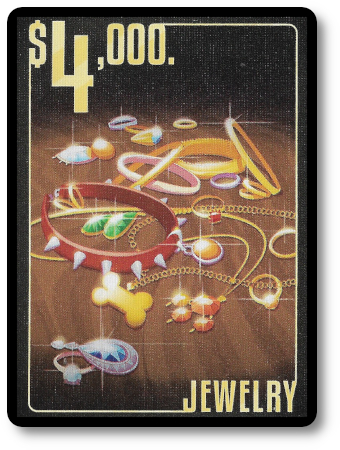
Third, create the Loot pile by shuffling the remaining Loot cards and placing the deck face down. Next, divide the deck into roughly equal piles based on the number of players. Randomly take “The Fuzz” card and shuffle it into one of the small piles indicated by the rules and number of players. Finally, stack each of the small piles on top of each other. Place this deck face-down and within easy reach of all the players.
That’s it for game set up. Determine who the first player is and give them The Boss marker.
Ca$h and Gun$
GoodCritters is played in rounds and turns with no set number of rounds per game. A game round is summarized here.
Step One: Show the Loot
The current Boss draws a specific number of Loot cards from the Loot deck and places them face up in the middle of the gaming area. Have all the players take a moment to review the now visible Loot cards. The player need only draw new Loot cards if all of the previous round’s Loot cards were successfully distributed.
Step Two: Distribute the Loot
The current Boss must now decide how the shown Loot cards will be distributed among the other players. There is no wrong or right way to go about this. It’s totally up to the Boss to decide who gets what. For example, the Boss could distribute the Loot as evenly as possible, only give it to one player (including themselves), or anywhere in between. Be creative and ruthless. The only hard rule here is that all the Loot must be distributed. You cannot keep some of the Loot cards for later.
Place the Loot cards in front of the players who will be receiving them, but none of the players should take those Loot cards and place them in their Stash.
Step Three: Choose Actions
Now the game gets a little bit crazy. First, all the players see how the Loot is currently being distributed. Most likely, there will be more than few players who are not in agreement with the Boss’s decision. So all the players can try to make any deals they like and talk as loudly as they want at the table. Players can make threats, bribes, ultimatums, pitiful complaints, outrageous demands, cries for help, and so on.
Anything goes here, with one exception…
“Threats” in the game should not be about harming any of the players. That would not be very pleasant. So instead, each player has a Threat marker. The player may place this in front of any of their opponents during this step of the round. Doing so means that the player may try to steal Loot by playing the “Rob” Action card. Of course, the real intent of the Threat marker is intended to be a bluff, but not always. A player is never required to play their “Rob” Action card even if they threaten an opponent.
And, yes, one player can be threatened by multiple opponents. Of course, this is a great way to ask for favors or provide favors in return for assistance.
This step continues until each player has played an Action card of their choice, face-down in front of them. Before that, players can change their minds about what Action card they want to play as often as they like.
As soon as every player has an Action card played, the time for talk is over.
Step Four: Resolve Actions and the Vote
All players now reveal their played Action card. Then, starting with the Boss and continuing in turn sequential order, each player resolves their Action card.
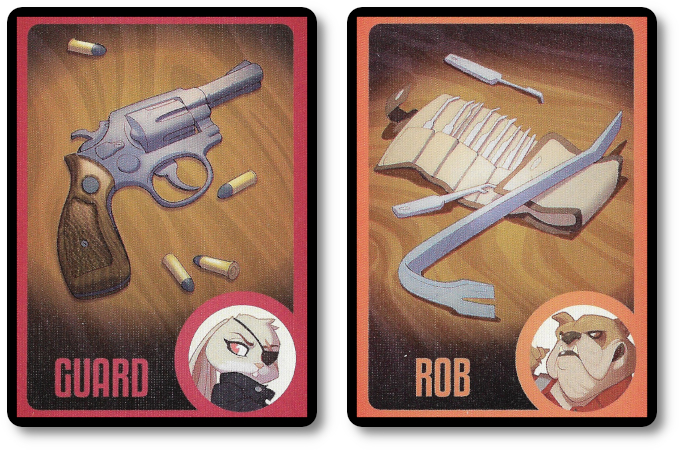
- Skim: This Action card allows the player to take the top Loot card from the Loot deck, placing it immediately within their Stash. Only the first player to resolve the “Skim” Action card gets to take this action and resolve their card. Any other players who also played the “Skim” Action card are out of luck.
- Rob: This Action card lets the player take the Loot cards from the opponent they placed the Threat marker on. The player randomly takes one Loot card from their opponent’s Stash, placing it immediately within their own Stash.
- Guard: This Action card blocks the “Rob” Action card if played on them. This is also the only Action card that can be revealed out of turn. Therefore, if the player is the target of a “Rob” Action card, they immediately reveal their “Guard” Action card. The player then randomly takes one Loot card from their opponent’s Stash, who attempted to rob them, placing it immediately within their own Stash. It should be noted that a “Guard” Action card protects the player from all attempts of theft, meaning the player may take from the Stash from any opponent who attempts to rob them during the round.
- Yes: This Action card indicates that the player agrees with the Boss and the current distribution of the Loot cards. No further action is required.
- No: This Action card indicates that the player is disgruntled with the Boss and disagrees with the current distribution of the Loot cards. No further action is required.
After all the players reveal and resolve their Action cards, they determine if the current Boss remains in power or the job goes to a new player.
- If there are more “Yes” Action cards showing than “No” Action cards, the current Boss player remains the Boss for the next round. Every player now takes their distributed Loot cards and places them in their own Stash.
- If more “No” Action cars are shown than “Yes” Action cards, the current Boss is ousted. The next player in turn order sequence who played a “No” Action card is now the new Boss. The distributed Loot is returned to the middle of the table and kept face-up. The new Boss adds two new Loot cards to the ones already shown, skipping step one in the next round, going right to step two.
- If there are an equal number of “Yes” and “No” Action cards showing (including none at all), the vote is a tie. Every player now takes their distributed Loot cards and places them in their own Stash. However, the gang has lost faith in the Boss’s ability to lead. Therefore, the Boss title is given to the next player in turn order sequence who becomes the new Boss in the next round.
This completes the round! All players should now take their played Action cards back into their card hand and remove any Threat markers played.
Continue with the next round until the game is completed.
Cheese It – The Cops!
The game continues, as noted above, until “The Fuzz” card is revealed.
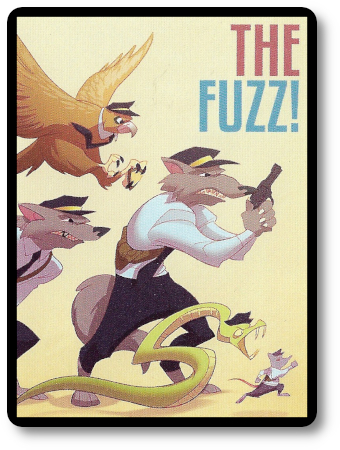
- The game ends immediately if “The Fuzz” card is revealed during step one or step four of the round when the visible Loot is revealed or added to.
- The game round ends normally if “The Fuzz” card is revealed when a player resolves the “Skim” Action card.
All players now add up the total value of their Loot cards in their Stash. The player with the most valuable Stash wins the game.
Game Variants
If step three is taking too long, consider having each player taking a single turn to make any threats, bribes, and the like. Afterward, each player places their Action card.
The players may optionally use “Payoffs” in the game. Each player is given two Payoff tokens, and five Payoff cards during game set up. Payoff cards are not kept in the player’s Stash and cannot be stolen. They can be used as bribes, however. This includes having other players guard their Stash, vote specific ways, or have the current Boss give them more Loot during the initial distribution. Players can even make promises about what they will or will not do during future rounds. Payoff cards are played out in the open and are always visible. Payoffs, however, are not enforceable. Players are entirely free to lie if they so choose or not fulfill the deal. However, this can be addressed by providing assurances through the Payoff tokens, which indicates the Action card the player must play to collect the Payoff. At the end of the game, any Payoff cards are added to the player’s total Stash for points.
To avoid having the same player be the Boss over and over again, set a limit to the number of times a player may own that role.
The game length can be adjusted by shifting the position of “The Fuzz” card during the game setup.
To learn more about GoodCritters, visit the game’s webpage.
Final Word
 The Child Geeks enjoyed the game a great deal, really hamming it up at the table and making outrageous claims of being cheated and questionable threats that no one could deliver. According to one Child Geek, “I liked the game a lot. You get to make a lot of fun at the table by talking to others and interacting to make some money!” Another Child Geek said, “The game is loud and can be confusing. All you need to do is keep voting yes when the money is good and no when the money is bad.” The Child Geeks had no problem learning the game and understanding the different ways to mess and cooperative with their opponents/team members. When the last buck was passed, the Child Geeks all voted that GoodCritters was the Boss.
The Child Geeks enjoyed the game a great deal, really hamming it up at the table and making outrageous claims of being cheated and questionable threats that no one could deliver. According to one Child Geek, “I liked the game a lot. You get to make a lot of fun at the table by talking to others and interacting to make some money!” Another Child Geek said, “The game is loud and can be confusing. All you need to do is keep voting yes when the money is good and no when the money is bad.” The Child Geeks had no problem learning the game and understanding the different ways to mess and cooperative with their opponents/team members. When the last buck was passed, the Child Geeks all voted that GoodCritters was the Boss.
 The Parent Geeks found the game to be fun but loud and chaotic at times. Sometimes a bit too loud. According to one Parent Geek, “The game requires a lot of energy and will only be fun if you are playing with folks who are excitable and extroverted. I’m not either. I think this is a fun game for larger groups who like games, but I found it a bit too much for a casual game.” Another Parent Geek disagreed, saying, “This is an outstanding party game. I had a lot of fun working with others, making threats, making deals, and winning the steals! I would play this again and again. So much fun!” When the last votes were in, the Parent Geeks were of two different minds regarding GoodCritters. Some very much enjoyed it, while others found it to be too frantic and chaotic at the table. It all came down to how each Parent Geek defined “casual gameplay.”
The Parent Geeks found the game to be fun but loud and chaotic at times. Sometimes a bit too loud. According to one Parent Geek, “The game requires a lot of energy and will only be fun if you are playing with folks who are excitable and extroverted. I’m not either. I think this is a fun game for larger groups who like games, but I found it a bit too much for a casual game.” Another Parent Geek disagreed, saying, “This is an outstanding party game. I had a lot of fun working with others, making threats, making deals, and winning the steals! I would play this again and again. So much fun!” When the last votes were in, the Parent Geeks were of two different minds regarding GoodCritters. Some very much enjoyed it, while others found it to be too frantic and chaotic at the table. It all came down to how each Parent Geek defined “casual gameplay.”
 The Gamer Geeks found GoodCritters to be simplistic, straightforward, but entertaining. According to one Gamer Geek, “I good game to play at conventions or with friends before a game or two with more depth. A great filler, I’d say. I found the rules to be a bit weak in some areas, but it is the players at the table that make the game entertaining.” Another Gamer Geek said, “I found this to be an OK game at best. I had fun but wouldn’t necessarily seek it out. I would play it again but won’t be asking for it anytime soon. I think you can only play this game well and enjoy it if you have players you are familiar with and are super comfortable with table talk. Otherwise, the game falls flat on its face.” When the final mob boss retired, the Gamer Geeks gave GoodCritters a mixed endorsement, much like the Parent Geeks.
The Gamer Geeks found GoodCritters to be simplistic, straightforward, but entertaining. According to one Gamer Geek, “I good game to play at conventions or with friends before a game or two with more depth. A great filler, I’d say. I found the rules to be a bit weak in some areas, but it is the players at the table that make the game entertaining.” Another Gamer Geek said, “I found this to be an OK game at best. I had fun but wouldn’t necessarily seek it out. I would play it again but won’t be asking for it anytime soon. I think you can only play this game well and enjoy it if you have players you are familiar with and are super comfortable with table talk. Otherwise, the game falls flat on its face.” When the final mob boss retired, the Gamer Geeks gave GoodCritters a mixed endorsement, much like the Parent Geeks.
 GoodCritters is a game that requires two essential elements: space to shout and players to actively participate in the shouting. This is a game of wit and wordplay, of quick decisions and sly bluffing. It’s not a game you just sit down a play. You must fully engage your brain and the other players while wheeling and dealing, or you won’t have a good time. It’s that simple.
GoodCritters is a game that requires two essential elements: space to shout and players to actively participate in the shouting. This is a game of wit and wordplay, of quick decisions and sly bluffing. It’s not a game you just sit down a play. You must fully engage your brain and the other players while wheeling and dealing, or you won’t have a good time. It’s that simple.
Of course, that also means that the game itself – no matter how good or bad the rules might be, in your opinion – is entirely dependent on the players. Which I know sounds stupid. Every game is dependent on the players, right? Yes and no, my friends. Most games require players to make decisions and complete their turns. By doing so, they move the game along by eventually reaching the endgame condition. In GoodCritters, it’s all about voting and getting others to vote in a way that allows you to win. There are no pieces to move. You must move your opponents. That’s what I mean by this game is dependent on the players. You move your opponents’ minds, opinions, and actions around like Chess pieces.
Hmm. I make the game sound epic, and it isn’t. But it is a stage that can provide for some epic gameplay and wonderful memories. This is a game that wants you to have fun, be outrageous, and make a lot of noise. Do so when you play it, and you won’t be disappointed. Approach the game with a timid heart or a soft voice, and you should expect to be really put out. Give it a try and see if this little gem makes you shout with glee.
This game was given to Father Geek as a review copy. Father Geek was not paid, bribed, wined, dined, or threatened in vain hopes of influencing this review. Such is the statuesque and legendary integrity of Father Geek.



